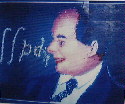New Millennium Artists - Digital Fine Art
Featuring the works of a select group of contemporary artists who have embraced computer technology as a new and exciting medium.
 Horizons 3 © 1996 Susumu Endo |
Stark & Stark is located at 993 Lenox Drive, Building Two, Lawrenceville.Opening Reception: Thursday March 11, 5:00 to 7:30 March 1 - April 30, 1999.The exhibit is free and the public is invited. Hours: Monday - Friday, 9:00 AM to 5:00 PM. |
 Princeton Arch ©1998 Michael Berger |
 John von Neumann © 1992 George Stibitz |
In the 1960’s and 1970’s business entered the computer age. The new technology soon spread into public awareness, affecting the lives and sparking the imagination of society. Artists, eager to explore the potential of the computer, kept pace with the changing tools and aesthetics of a new medium. As we approach the millennium, "Digital Art" in its many variations will be celebrating some 40 years of growth. |
Featured Artists are Michael Berger, George Cramer, Uri Dotan, Susumu Endo, Charlotte Sommer-Landgraf, Dale Leifeste, David Scott Leibowitz, Manfred Mohr, Barbara Nessim, Lillian Schwartz and Roman Verostko.
The exhibit is curated by Mary Lou Bock of The Williams Gallery of Princeton, a premier gallery for the showcasing of digital fine art; Ms. Bock represents the artists in the show, and additional works may be seen at the gallery’s 8 Chambers Street location. For additional information about the firm Stark & Stark or for directions to their offices please contact their web-site: www.stark-stark.com
Some Observations
In 1987 IBM Corporation sponsored the show "Digital Visions:
Computers and Art" in New York City. In an introduction to the catalog
Cynthia Goodman, curator and art historian, wrote:
"Computers are making unprecedented aesthetic experiences possible and revolutionizing the way art is conceived, created and perceived. The profound impact of digital technology on the art of the last twenty years and what it portends for the future is only beginning to be appreciated……No other medium has had such an extraordinary effect on all the visual art so soon after its inception. Painters, sculptors, architects, printmakers, filmmakers, and video and performance artists, irrespective of their stylistic creed, are responding to the rapidly developing possibilities of the new, quickly evolving technology and the dazzling array of options computers offer them and the art-viewing public alike."
In 1997, in the book "…Understanding New Media" Bolter and Grusin devote a good portion of their study to Digital Fine Art. They challenge the theory of many "new media" critics who assume "that digital technologies such as the World Wide Web, virtual reality, and computer graphics must divorce themselves from earlier media for a new set of aesthetic and cultural principle. They argue that "new visual media achieve their cultural significance precisely by paying homage to, rivaling and refashioning such earlier media as perspective painting, photography, film and television." John David Bolter is Wesley Professor of New Media Studies, and Richard Grusin is Professor and Chair, both at the School of Literature, Communication, and Culture at Georgia Institute of Technology.
The development of the computer and it's potential in the fine
arts as foreseen by George Stibitz, comptuing pioneer
George Stibitz, born in York, Pennsylvania in 1903, may be considered to be the
father of the modern digital computer. It is of great interest to me that one of the
earliest developers of the binary computer was himself an accomplished artist painting in
oils and a variety of other mediums. He was among the first to experiment with visual
imaging on the computer in relation to military and biological imaging in the early
1940’s.
After earning his MS in physics in 1927 he completed his Ph.D. in 1930 and accepted a position with Bell Laboratories in New York City. In 1937, on observing the similarity between the "on-off" positions of electronic relays and the binary "one or Zero" notation in mathematics, he constructed a one digit binary calculator. Named the "Model-K", the "K" stood for the kitchen table on which it was assembled. His colleagues at Bell Labs expressed interest as to whether this little relay calculator could be expanded to perform complex mathematics, and in 1939 the Complex Calculator was completed and put into use at the Laboratories.
Stibitz’s interest in the use of the computer as an artistic medium developed as he realized the powerful manipulative techniques of form and color which it provided. In 1949 he gave a paper (Oak Ridge National Laboratories) on the function of the computer with emphasis on the "non-numerical" uses. In his 80’s, after suffering a stroke Stibitz fell back on his artistic expression as some solace for losing his once-great ability to program computers. His portrait of John Von Neumann, theoretical chemist, physicist, computer designer, genius, was done using an Amiga 500 computer, Delux Paint program & Delta Graphics. The image on display is a Canon color copy of the original which is the property of the estate of George Stibitz
Home Page
| Artwork
| Framing
| Restoration
| Shows & Events
| Online Store
| Master Works
| Pioneers
| Princeton
Willard Page Collection
| William Bock's Fine Art Catalog Rasoniee
Contact Us
| About Us
| Art Links